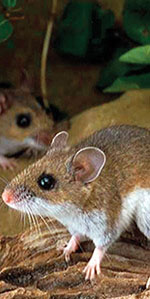| Deermouse | ||
 |
Classification(s) : | Prey |
| Cat Name : | Mouse | |
| Common Name : | Deermouse | |
| Scientific Name : | Peromyscus maniculatus | |
| Other Name(s) : | ||
| Physical Description : | The deermouse is a very small rodent with large eyes and ears that make their senses of sight and hearing excellent. They have a wide range of pelt color, but all of them have a white underside and white feet. |
|
| Physical Statistics : | Length: 3 – 4 Inches (8 – 10 Centimeters) |
|
| Behavior : | During the day, deermice rest or stay close to their burrows or nests hidden in trees. They forage at night, eating various seeds, nuts, fruits, and insects. They are known to be very good at climbing and tunneling. |
|
| Social Organization : | Deermice are solitary animals whose home territories occasionally overlap. Both males and females care for litters. |
|
| Approval Level : | None; Deermice are very common and would most likely not cause any major plots IC. | |
| Kill Difficulty : | Low; These mice rarely come out in the daytime, but once spotted they are easy to sneak up on and have very little ability to defend themselves. |
|
| Training Level : | General; Though fast, deermice can be excellent prey for apprentices to practice stalking. |
|
| Hunting Tactic : | Land Rodents | |
| Food Quality : | Medium; Deermice are a tasty and nutritious treat for cats, though their small size may make them a meal for only one cat. | |
| Herbal Use : | Mouse - The inner-coat of the mouse may be used to stem the flow of blood from a wound, while the bile is effective at removing ticks and fleas. |
|
